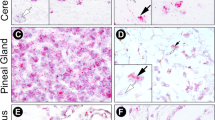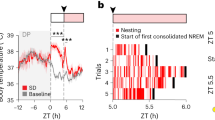Abstract
THE association between brain monoamines and nerve terminals has been interpreted as evidence of a neuro-transmitter function. It has been shown that serotonin (5-hydroxytryptamine, 5HT) is localized in fine neurones which project to the forebrain. and whose cell bodies lie in the raphé nuclei of the midbrain1,2. The transmitter hypothesis has been further substantiated by the finding that stimulation of these nuclei increases forebrain levels of 5-hydroxyindol-3-ylacetic acid (5HIAA), the metabolite of 5HT3, and increases the release of 5HT from brain into cortical cups4. Using the rate of formation of 5-hydroxy-indoles after tryptophan administration in vivo as an index of the rate of hydroxylation of tryptophan5, the limiting step in the synthesis of 5HT, stimulation has been shown not only to increase release of 5HT but also to accelerate the rate of production of the amine (unpublished observations of D. Eccleston, M. Randic and A. Padjen). This could arise from immediate electrical effects on membrane permeability with changes in transport of substrate to existing enzyme. We have examined whether the increased rate of amine production continues after stimulation has ceased, which would suggest that the stimulation caused enzyme induction.
This is a preview of subscription content, access via your institution
Access options
Subscribe to this journal
Receive 51 print issues and online access
$199.00 per year
only $3.90 per issue
Buy this article
- Purchase on Springer Link
- Instant access to full article PDF
Prices may be subject to local taxes which are calculated during checkout
Similar content being viewed by others
References
Dahlstrom, A., and Fuxe, K., Acta Physiol. Scand., 62, Suppl. 232, 1 (1964).
Anden, N.-E., Dahlstrom, A., Fuxe, K., Larsson, K., Olson, L., and Ungerstedt, U., Acta Physiol. Scand., 67, 313 (1966).
Aghajanian, G. K., Rosecrans, J. A., and Sheard, M. H., Science, 156, 402 (1966).
Eccleston, D., Randic, M., Roberts, M. H. T., and Straughan, D. W., Metabolism of Amines in Brain (edit. by Hooper, G.) (Macmillan, London, 1969).
Moir, A. T. B., and Eccleston, D., J. Neurochem., 15, 1093 (1968).
Eccleston, D., Reading, H. W., and Ritchie, I. M., J. Neurochem., 16, 274 (1969).
Author information
Authors and Affiliations
Rights and permissions
About this article
Cite this article
ECCLESTON, D., RITCHIE, I. & ROBERTS, M. Long Term Effects of Midbrain Stimulation on 5-Hydroxyindole Synthesis in Rat Brain. Nature 226, 84–85 (1970). https://doi.org/10.1038/226084a0
Received:
Issue Date:
DOI: https://doi.org/10.1038/226084a0
This article is cited by
Comments
By submitting a comment you agree to abide by our Terms and Community Guidelines. If you find something abusive or that does not comply with our terms or guidelines please flag it as inappropriate.



